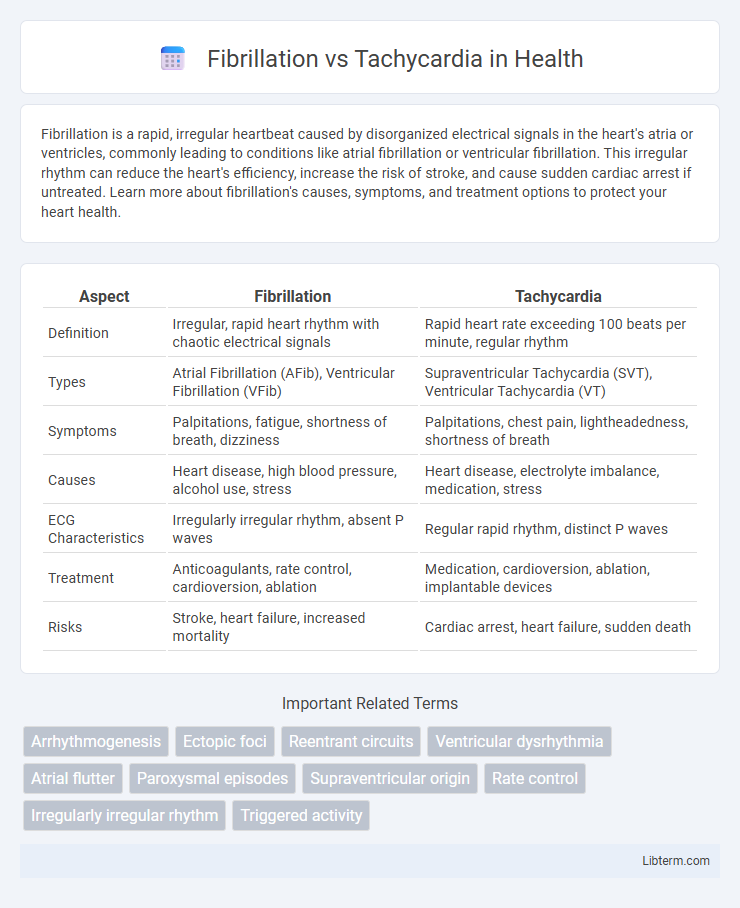Fibrillation is a rapid, irregular heartbeat caused by disorganized electrical signals in the heart's atria or ventricles, commonly leading to conditions like atrial fibrillation or ventricular fibrillation. This irregular rhythm can reduce the heart's efficiency, increase the risk of stroke, and cause sudden cardiac arrest if untreated. Learn more about fibrillation's causes, symptoms, and treatment options to protect your heart health.
Table of Comparison
| Aspect | Fibrillation | Tachycardia |
|---|---|---|
| Definition | Irregular, rapid heart rhythm with chaotic electrical signals | Rapid heart rate exceeding 100 beats per minute, regular rhythm |
| Types | Atrial Fibrillation (AFib), Ventricular Fibrillation (VFib) | Supraventricular Tachycardia (SVT), Ventricular Tachycardia (VT) |
| Symptoms | Palpitations, fatigue, shortness of breath, dizziness | Palpitations, chest pain, lightheadedness, shortness of breath |
| Causes | Heart disease, high blood pressure, alcohol use, stress | Heart disease, electrolyte imbalance, medication, stress |
| ECG Characteristics | Irregularly irregular rhythm, absent P waves | Regular rapid rhythm, distinct P waves |
| Treatment | Anticoagulants, rate control, cardioversion, ablation | Medication, cardioversion, ablation, implantable devices |
| Risks | Stroke, heart failure, increased mortality | Cardiac arrest, heart failure, sudden death |
Understanding Cardiac Arrhythmias: Fibrillation vs Tachycardia
Fibrillation involves rapid, irregular heartbeats caused by chaotic electrical impulses, leading to ineffective atrial or ventricular contractions. Tachycardia is characterized by an abnormally fast but regular heart rate, typically exceeding 100 beats per minute, resulting from accelerated electrical signals. Distinguishing fibrillation from tachycardia is crucial for accurate diagnosis and targeted treatment of cardiac arrhythmias to prevent complications like stroke or heart failure.
Definition and Key Differences
Fibrillation refers to rapid, irregular, and unsynchronized contractions of heart muscle fibers, often seen in atrial or ventricular fibrillation, which disrupt normal blood flow and can lead to serious complications. Tachycardia is characterized by a fast heart rate exceeding 100 beats per minute, resulting from various causes such as sinus tachycardia or supraventricular tachycardia, where the heartbeat remains regular but abnormally fast. The key difference lies in fibrillation causing erratic and ineffective contractions, while tachycardia involves a rapid but coordinated heartbeat.
Causes and Risk Factors
Fibrillation, such as atrial fibrillation, is caused by irregular electrical signals in the heart's atria, often linked to high blood pressure, heart valve disease, and chronic lung conditions. Tachycardia originates from abnormally fast heart rhythms due to factors like electrolyte imbalances, congenital heart defects, or excessive stimulant intake, including caffeine and tobacco. Both conditions share overlapping risk factors like age, coronary artery disease, and previous heart surgery, increasing the likelihood of arrhythmias.
Symptoms and Clinical Presentation
Fibrillation presents with irregular, often rapid heartbeats causing palpitations, dizziness, and fatigue, commonly seen in atrial fibrillation with an irregularly irregular pulse. Tachycardia involves a consistently fast heart rate above 100 beats per minute, producing symptoms such as chest pain, shortness of breath, and syncope due to reduced cardiac output. Both conditions may present with overlapping symptoms like palpitations and lightheadedness but differ in rhythm regularity and response to medical intervention.
Diagnostic Approaches
Electrocardiography (ECG) is the primary diagnostic tool for distinguishing fibrillation from tachycardia by analyzing heart rhythm patterns; atrial fibrillation presents as irregularly irregular QRS complexes without distinct P waves, while tachycardia exhibits a rapid but regular rhythm with discernible P waves or abnormal QRS morphology. Holter monitoring and event recorders provide extended rhythm surveillance to detect paroxysmal episodes and assess arrhythmia burden in both conditions. Advanced imaging such as echocardiography evaluates structural heart abnormalities that contribute to arrhythmogenesis, aiding in differential diagnosis and treatment planning.
Types of Fibrillation
Atrial fibrillation and ventricular fibrillation are the two primary types of fibrillation, each characterized by chaotic electrical activity in the heart's atria or ventricles, respectively. Atrial fibrillation leads to irregular and often rapid heart rate, increasing the risk of stroke, while ventricular fibrillation causes the heart to quiver ineffectively, resulting in a life-threatening emergency requiring immediate defibrillation. Understanding the distinct electrical patterns and clinical implications of these fibrillation types is critical for accurate diagnosis and effective treatment in cardiac care.
Types of Tachycardia
Tachycardia encompasses several types, including atrial tachycardia, ventricular tachycardia, and supraventricular tachycardia, each characterized by an abnormally fast heart rate originating from different parts of the heart. Atrial fibrillation, in contrast, involves rapid, irregular electrical signals causing the atria to quiver instead of contracting effectively, leading to an irregular heartbeat. Understanding the specific type of tachycardia is critical for targeted treatment and distinguishing it from fibrillation by analyzing heart rhythm patterns via ECG.
Treatment Options and Management
Fibrillation treatment primarily involves anticoagulants like warfarin or direct oral anticoagulants (DOACs) to prevent stroke, alongside rhythm or rate control strategies using beta-blockers, calcium channel blockers, or antiarrhythmic drugs. Tachycardia management depends on the type but often includes vagal maneuvers for supraventricular tachycardia (SVT), medications such as adenosine or beta-blockers, and in some cases, catheter ablation to restore normal heart rhythm. Both conditions may require implantable devices like pacemakers or defibrillators for recurrent or refractory cases to ensure effective heart rate control and reduce complications.
Potential Complications
Fibrillation, characterized by rapid, irregular heartbeats, poses significant risks including stroke and heart failure due to inefficient blood flow and clot formation. Tachycardia involves an abnormally fast heart rate that can lead to complications such as cardiomyopathy, syncope, or sudden cardiac arrest if left untreated. Both conditions require prompt medical evaluation to prevent long-term cardiac damage and improve patient outcomes.
Prevention and Lifestyle Considerations
Preventing fibrillation and tachycardia involves maintaining heart health through regular physical activity, a balanced diet rich in omega-3 fatty acids, and avoiding excessive caffeine and alcohol consumption. Managing stress through mindfulness techniques and ensuring adequate sleep are critical lifestyle factors that reduce arrhythmia risk. Regular medical checkups to monitor blood pressure and heart rhythm, along with adherence to prescribed medications, support effective prevention of these common cardiac conditions.
Fibrillation Infographic

 libterm.com
libterm.com